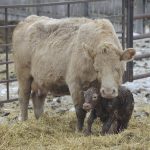Bovine respiratory disease is one of the most common and economically important diseases of the beef industry in North America. The risk factors have been well-described and the most important risk factor continues to be weaning. Weaning causes significant stress to the calf and can have major impacts on the calf’s immune system. Reducing weaning […] Read more
Stories by John Campbell, DVM, DVSC
Fog fever: a respiratory syndrome that is often deadly
Several veterinarians have diagnosed outbreaks of pneumonia in adult cows that were recently moved to a new pasture. Pneumonia in adult cows is uncommon and these specific cases were attributed to a condition known as fog fever. The unique name is somewhat confusing. Fog fever is a common name for Acute Bovine Pulmonary Emphysema (ABPE). […] Read more
Farms should develop antibiotic protocols for livestock
Health Canada has recently proposed changes to the Food and Drug Regulations related to antimicrobial resistance. These proposals will affect few beef producers, unless they are buying antimicrobials from outside the country through the own-use importation rule. However, governments and society in general have expressed concerns about the dangers of antimicrobial resistance, and the use […] Read more
Investigating health repercussionsof manganese deficiency in cattle
As part of disease investigations, we often evaluate trace mineral levels in the blood of cattle. Over the last few months, I’ve had several herds show very low levels of manganese, and although the results did not seem related to the problems being investigated, it sparked my interest in finding out more about issues associated […] Read more
BVD vaccine reduces fetal infections, abortions: study
Bovine viral diarrhea virus is one of the most important viruses affecting the North American cattle industry. I have witnessed the wide variety of ways in which this virus can cause devastating economic losses in terms of infertility, abortions, stillbirths and calf deaths. It is not surprising that the disease is an important and vital […] Read more

Alternative practices, products can reduce antibiotic use
Antimicrobial resistance is a significant global public health concern, and the use of antibiotics for agricultural animals is often cited as one potential factor that may be contributing to the problem. The continuing effectiveness of antimicrobial drugs is also of vital importance for animal agriculture from a disease control and treatment perspective. If bacteria for […] Read more

Vaccinating young calves: what works, what may not
Getting a young beef or dairy calf off to a good start always involves ensuring adequate colostral intake. The calf has few antibodies in its blood stream at birth, and this first milk contains large quantities of antibodies from the dam. These antibodies are absorbed by the calf and provide important maternal immunity for the […] Read more
It makes sense to do a breeding soundness examination
We are approaching the breeding season for many cow-calf herds, and most ranches have already booked or will soon book their local veterinarian for a bull breeding soundness examination. Breeding soundness examinations, also known as “bull testing,” were initiated in the early 1950s in North America. It appears that a fierce central Colorado blizzard in […] Read more

Studies show late day feeding may encourage more daylight calving
More than two-thirds of calf deaths occur within the first 96 hours of life. At least two-thirds of these mortalities can be attributable to calving difficulties or dystocia. Calves that are born to a cow or heifer suffering from calving difficulties are about 2.5 times more likely to get sick in the first 45 days. […] Read more

A calf’s first meal is the most important one it will have
UPDATED: September 12, 2025 – The first time a calf suckles after birth could be labelled as the most important meal that the calf ever consumes. Adequate colostrum intake is essential to getting a calf off to a good start. Newborn calves are born with virtually no immunity of their own. The cow’s placenta does not […] Read more




